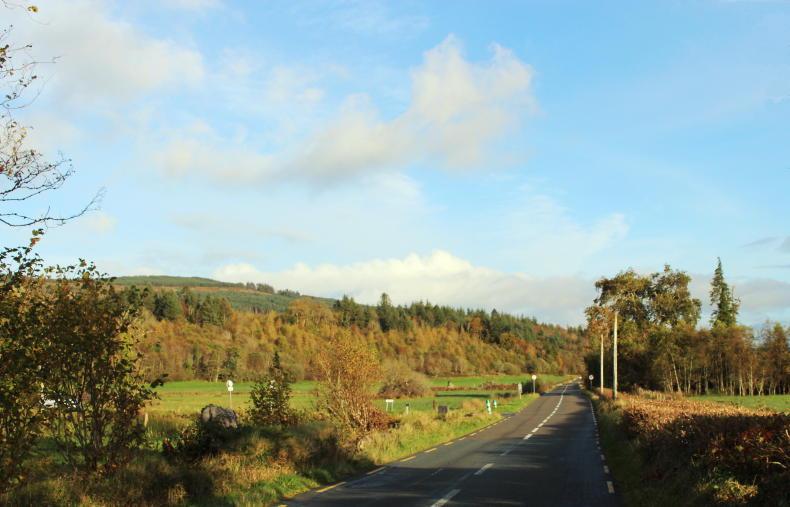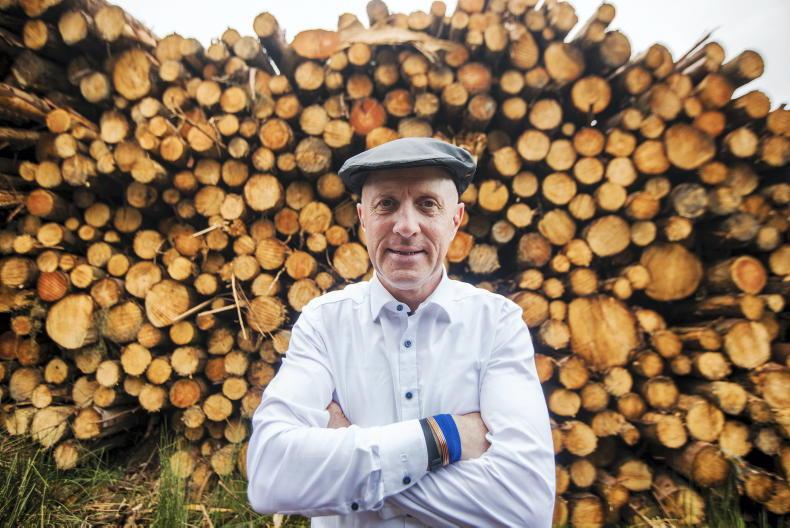After a decade of discussions on the role of forestry in climate change mitigation, Ireland should at least have an annual afforestation target and a plan on how to implement it.
That it has neither is an indictment of the current structures within which the sector operates.
The 2021 Climate Action Plan identifies afforestation as “the single largest land-based climate change mitigation measure available to Ireland” but paradoxically fails to recommend a planting target.
The authors of the 2019 Climate Action Plan state that “to meet the required level of emissions reduction, by 2030 we will [achieve] an average of 8,000ha per annum of newly planted forest, and sustainable forest management (21 MtCO2eq cumulative abatement)”.
Most commentators believe this level of planting will be insufficient. Dr David Styles, NUI Galway, recommends an annual programme of 20,000ha, while COFORD, the Department’s advisory forestry body, recommends planting “to a level approaching 16,000ha per year”.
If we are to assume that COFORD’s target is the recommended level of planting to help Ireland achieve its carbon-neutral goal, then the Department needs to adopt it as policy and the Government needs to write it into the Climate Action Plan. Stakeholders also need to know how this will be achieved and its consequences for Irish agriculture and forestry.
All the sector has at the moment is a set of afforestation scenarios based on business as usual, Coillte’s recent commitment to plant 100,000ha by 2050, COFORD’s and Dr Styles’s recommendations, and a farm forestry carbon-based scheme recommended by the Society of Irish Forester (Figure 1).
A group of stakeholders including the IFA, Forest Industries Ireland (FII), all the main forestry companies and sawmills, UCD, Waterford IT, Irish Timber Growers Association, Society of Irish Foresters (SIF), forestry consultants and nurseries believe that a new approach is required.
They have outlined their views in a paper, “The need for a Forestry Development Agency (FDA) to achieve a sustainable forestry and forest products sector in Ireland”.
They believe that existing Department structures were never designed to cope with the complexities now required to deliver a multipurpose forestry programme.
“Retaining these structures will result in business as usual as they were never designed to respond to the challenges and opportunities presented by climate change, an increased afforestation programme, wood mobilisation and non-wood functions,” said Pat O’Sullivan of the Society of Irish Foresters.
“What is needed is a new and innovative approach that actually incentivises farmers and other landowners to afforest part of their land while addressing barriers to afforestation, harvesting and forest road construction to access forests.”
Report coauthor Henry Phillips said an FDA would actively support all aspects of sustainable forest management (SFM) and forest certification.
“Less than 7% of private forests are certified and by 2040, an additional 24.6 million m3 of private sector production will require certification if the processing sector is to develop and process increased volumes,” he said.
The document states: “The need for change was never more urgent, especially when viewed against the background of recent developments in the sector. The importance of forests in combating climate change has been recognised by the United Nations Framework Convention on Climate Change, and in Ireland’s Climate Action Plan.”
It also states that an FDA is needed to address the role of wood as “a sustainable substitute for conventional carbon-heavy construction products, such as concrete, brick and steel” as recommended in the Climate Action Plan.
The stakeholders’ document identifies the need for a land use policy in Ireland which would address land availability for forestry.
This is also an issue that Coillte plans to address to ensure it achieves its 100,000ha planting programme by 2050.
The FDA proposers are convinced that increased afforestation by farmers is vital to the success of the forestry sector.
Farmers now plant less than 600ha annually compared with over 5,000ha nine years ago.
A new approach will also deliver non-wood benefits that society expects such as recreation, landscape enhancement, biodiversity and tourism
“The FDA is a new approach that would deliver a scheme that will leverage the carbon value sequestered by forests and use this to reward farmers and landowners to undertake an annual afforestation programme of 16,000ha,” according to Henry Phillips.
“A new approach will also deliver non-wood benefits that society expects such as recreation, landscape enhancement, biodiversity and tourism.”
Forestry is the only natural resource sector without an FDA-type organisation to lead and promote it, unlike ports and shipping (IMDO), food (Bord Bia), sea fisheries (BIM), inland fisheries (IFI), marine research (Marine Institute) and renewable energy (SEI).
“The creation of an independent FDA would optimise the performance of Ireland’s most important natural and renewable resource by providing dynamic leadership,” said Michael Guilfoyle, one of the authors of the proposal.
Forestry certification conference to take place in Dublin this month
Ireland has been chosen to host the 1922 International Programme for the Endorsement of Forest Certification (PEFC) conference in the Royal Marine Hotel, Dun Laoghaire, on Thursday 12 May.
“The conference theme is Mitigating Climate Change: Win with Wood,” said William Merivale, PEFC national secretary. “We are delighted that Minister of State Pippa Hackett will launch the event which features a wide range of Irish and international speakers, including Dr Pablo van der Lugt, Delft University who will provide the keynote address ‘Tomorrow’s timber – circular thinking and timber as a future-proof building material choice’.”
To book for the last remaining places, those interested should contact PEFC (pefcireland@protonmail.com) by this Friday.
After a decade of discussions on the role of forestry in climate change mitigation, Ireland should at least have an annual afforestation target and a plan on how to implement it.
That it has neither is an indictment of the current structures within which the sector operates.
The 2021 Climate Action Plan identifies afforestation as “the single largest land-based climate change mitigation measure available to Ireland” but paradoxically fails to recommend a planting target.
The authors of the 2019 Climate Action Plan state that “to meet the required level of emissions reduction, by 2030 we will [achieve] an average of 8,000ha per annum of newly planted forest, and sustainable forest management (21 MtCO2eq cumulative abatement)”.
Most commentators believe this level of planting will be insufficient. Dr David Styles, NUI Galway, recommends an annual programme of 20,000ha, while COFORD, the Department’s advisory forestry body, recommends planting “to a level approaching 16,000ha per year”.
If we are to assume that COFORD’s target is the recommended level of planting to help Ireland achieve its carbon-neutral goal, then the Department needs to adopt it as policy and the Government needs to write it into the Climate Action Plan. Stakeholders also need to know how this will be achieved and its consequences for Irish agriculture and forestry.
All the sector has at the moment is a set of afforestation scenarios based on business as usual, Coillte’s recent commitment to plant 100,000ha by 2050, COFORD’s and Dr Styles’s recommendations, and a farm forestry carbon-based scheme recommended by the Society of Irish Forester (Figure 1).
A group of stakeholders including the IFA, Forest Industries Ireland (FII), all the main forestry companies and sawmills, UCD, Waterford IT, Irish Timber Growers Association, Society of Irish Foresters (SIF), forestry consultants and nurseries believe that a new approach is required.
They have outlined their views in a paper, “The need for a Forestry Development Agency (FDA) to achieve a sustainable forestry and forest products sector in Ireland”.
They believe that existing Department structures were never designed to cope with the complexities now required to deliver a multipurpose forestry programme.
“Retaining these structures will result in business as usual as they were never designed to respond to the challenges and opportunities presented by climate change, an increased afforestation programme, wood mobilisation and non-wood functions,” said Pat O’Sullivan of the Society of Irish Foresters.
“What is needed is a new and innovative approach that actually incentivises farmers and other landowners to afforest part of their land while addressing barriers to afforestation, harvesting and forest road construction to access forests.”
Report coauthor Henry Phillips said an FDA would actively support all aspects of sustainable forest management (SFM) and forest certification.
“Less than 7% of private forests are certified and by 2040, an additional 24.6 million m3 of private sector production will require certification if the processing sector is to develop and process increased volumes,” he said.
The document states: “The need for change was never more urgent, especially when viewed against the background of recent developments in the sector. The importance of forests in combating climate change has been recognised by the United Nations Framework Convention on Climate Change, and in Ireland’s Climate Action Plan.”
It also states that an FDA is needed to address the role of wood as “a sustainable substitute for conventional carbon-heavy construction products, such as concrete, brick and steel” as recommended in the Climate Action Plan.
The stakeholders’ document identifies the need for a land use policy in Ireland which would address land availability for forestry.
This is also an issue that Coillte plans to address to ensure it achieves its 100,000ha planting programme by 2050.
The FDA proposers are convinced that increased afforestation by farmers is vital to the success of the forestry sector.
Farmers now plant less than 600ha annually compared with over 5,000ha nine years ago.
A new approach will also deliver non-wood benefits that society expects such as recreation, landscape enhancement, biodiversity and tourism
“The FDA is a new approach that would deliver a scheme that will leverage the carbon value sequestered by forests and use this to reward farmers and landowners to undertake an annual afforestation programme of 16,000ha,” according to Henry Phillips.
“A new approach will also deliver non-wood benefits that society expects such as recreation, landscape enhancement, biodiversity and tourism.”
Forestry is the only natural resource sector without an FDA-type organisation to lead and promote it, unlike ports and shipping (IMDO), food (Bord Bia), sea fisheries (BIM), inland fisheries (IFI), marine research (Marine Institute) and renewable energy (SEI).
“The creation of an independent FDA would optimise the performance of Ireland’s most important natural and renewable resource by providing dynamic leadership,” said Michael Guilfoyle, one of the authors of the proposal.
Forestry certification conference to take place in Dublin this month
Ireland has been chosen to host the 1922 International Programme for the Endorsement of Forest Certification (PEFC) conference in the Royal Marine Hotel, Dun Laoghaire, on Thursday 12 May.
“The conference theme is Mitigating Climate Change: Win with Wood,” said William Merivale, PEFC national secretary. “We are delighted that Minister of State Pippa Hackett will launch the event which features a wide range of Irish and international speakers, including Dr Pablo van der Lugt, Delft University who will provide the keynote address ‘Tomorrow’s timber – circular thinking and timber as a future-proof building material choice’.”
To book for the last remaining places, those interested should contact PEFC (pefcireland@protonmail.com) by this Friday.









SHARING OPTIONS